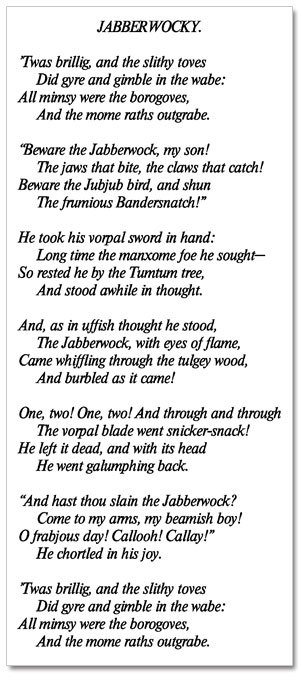ELA: Using Jabberwocky to Discuss Sentence Structure and Meaning
Nonsense Words Have Meaning and Specific Function
Resource: "Jabberwocky" by Lewis Carroll, additional information by The Poetry Foundation
The famous Lewis Carroll poem "Jabberwocky" is an example of a simple, narrative structure that is made much more complex with the use of unfamiliar words. What makes it unique is that these unfamiliar words are made up, but meaning is easily inferred by using close reading strategies. Taken by themselves, the words are meaningless, but in context the language is clear.
While specific vocabulary is important, so is context. We can teach our students to "read around" difficult words, finding their probable meaning from the context and from the sentence structure.
Especially for struggling readers, teaching close reading strategies that allow them to infer meaning and continue with the text is very important. Many students who lack these skills will come to a full stop on a difficult word, feeling unable to read on. Using Jabberwocky, students can feel empowered to select the most likely meaning based on context, test that meaning against the surrounding words, and more on without feeling defeated by unknown vocabulary.
Step One: Selecting an individual unknown vocabulary word.
Choose a nonsense word from the poem (recommended: frumious, brillig, manxome) and ask the students to define it. One or two students in the class may already have seen this poem, and may have a passing memory of what these words might mean. It is also featured in the recent Disney live-action remake of Alice in Wonderland.
Some students may appear confused or even frustrated. Many may not want to contribute to the discussion. Use your white board or collaborative tool (such as a Google Classroom discussion, or a Padlet board) to record examples of students' attempt at defining the word. Be sure to ask "how did you come up with that meaning?" and record that along with the definition.
Step Two: Acknowledge the challenge. Invite discussion.
Offer a possible definitions for your chosen word, based entirely on the construction of the word itself. For example: frumious means being a step above furious; brillig is a very smart pig; manxome is a way of saying someone is both manly and handsome. The students will then evaluate your definition for meaning without using context. Ask: "does this definition look right, sound right, and feel right? Why or why not?" Have the class vote on a single, working definition for this word.
Step Three: Give the sentence where your chosen word is located.
Students will now have access to some context. This may provide even further confusion at first, because additional confusing vocabulary is now included. For example: "Twas brillig and the slithy toves did gyre and gimble in the wabe" will immediately illicit a confused, if not even betrayed response from the students. Now, in addition to "brillig," the students are faced with "slithy," "toves," "gyre," "gimble," and "wabe." Remind the students that their job is still to find the definition of "brillig" or whatever word you started with. Read the line again to the students, and have them read it to themselves. Ask the following questions:
-What kind of text do you think we are reading?
-What might the subject of this text be?
-What images come into your mind when you imagine the setting of this text?
Students will often come to the conclusion that this is a work of fantasy, and most likely a poem or story. They may determine that the subject of the sentence might be the "slithy toves." They will likely decide this is some kind of fantastic setting, like magical forest or swamp.
Step Four: Revisit parts of speech
Use the board, overhead projector, or a pre-made resource to discuss the common parts of speech. Include noun, verb, adverb, adjective. Discuss subject, object, predicate. Now, looking at the selected word in the context of the sentence, ask the students to discuss the following with their groups:
-What part of speech do you think this word is?
-What function does it serve in this sentence?
-How does this help you understand the meaning?
Have the groups share back to the class, and record the results on the board.
Step Five: The whole poem, handouts and read aloud
Now, give each student a copy of the poem as well as highlighters, pens, or markers so they can highlight text. Read the poem aloud, placing emphasis on nonsense words. Now the students have access to the entire poem, and several new unknown words. Assign these new words to groups of students, and have them come up with their best definitions based on context. Have them determine a working definition, the part of speech, and the function in the sentence. After a few minutes, read back through the poem, having groups add their definitions as you arrive at each nonsense word. Ask the following questions:
-What did your group decide the likely definition of this word is?
-What part of speech is it, based on the words around it?
-What function does it serve in the sentence?
Allow other students to suggest alternative definitions. Allow the class to come to a consensus. Annotate a copy of the poem either through an electronic resource, or on an overhead projector.

Step Six: What worked well?
Work through any remaining nonsense words using the same strategies, and complete the poem. As an exit ticket, have the students individually respond to the question: what strategies worked well for you, and what did you learn today? Consider using Google Classroom or Padlet for that feedback, so that students can see the answers of other students. Remind students that the goal for working through difficult vocabulary is to use the structure of the words themselves, context clues, and an understanding of parts of speech to attempt their own definition. It will make them stronger, more confident readers.